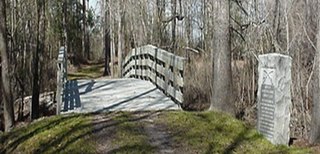 W
WThe Burnham Tavern is a historic tavern at 14 Colonial Way in Machias, Maine, United States. Built in 1770, it is one of the oldest surviving buildings in the Machias area, and is known for its locally significant role in the American Revolutionary War. The tavern is operated as the Burnham Tavern Museum by the Hannah Weston Chapter of the Daughters of the American Revolution (DAR). Featuring late 18th period furnishings, the house includes artifacts from the 1775 Battle of Machias, the first naval battle of the Revolution. The building was listed on the National Register of Historic Places in 1973.
 W
WFort Laurens was an American Revolutionary War fort on a northern tributary of the Muskingum River in what would become Northeast Ohio, United States. The fort's current location is in the town of Bolivar, Ohio, along the Ohio and Erie Canal Towpath Trail.
 W
WFort Morris is an earthen works fort in Liberty County, Georgia, in the United States. The fort is on a bend in the Medway River and played an important role in the protection of southeast Georgia throughout various conflicts beginning in 1741 and ending in 1865 at the conclusion of the American Civil War, including the French and Indian and American Revolutionary Wars and War of 1812. The historic site is 70 acres (28 ha) in size and sits at an elevation of 23 feet (7.0 m).
 W
WFort Morris Historic Site is a Georgia state historic park in Liberty County, Georgia in the United States. The fort is on a bend in the Medway River and played an important role in the protection of southeast Georgia throughout various conflicts beginning in 1741 and ending in 1865 at the conclusion of the American Civil War, including the French and Indian and American Revolutionary Wars and War of 1812. The historic site is 70 acres (28 ha) and sits at an elevation of 23 feet (7.0 m).
 W
WFort Randolph was an American Revolutionary War fort which stood at the confluence of the Ohio and Kanawha Rivers, on the site of present day Point Pleasant, West Virginia, USA.
 W
WGeorge Rogers Clark National Historical Park, located in Vincennes, Indiana, on the banks of the Wabash River at what is believed to be the site of Fort Sackville, is a United States National Historical Park. President Calvin Coolidge authorized a classical memorial and President Franklin D. Roosevelt dedicated the completed structure in 1936.
 W
WGuilford Courthouse National Military Park, at 2332 New Garden Road in Greensboro, Guilford County, North Carolina, commemorates the Battle of Guilford Court House, fought on March 15, 1781. This battle opened the campaign that led to American victory in the Revolutionary War. The loss by the British in this battle contributed to their surrender at Yorktown seven months later. The battlefield is preserved as a National Military Park and operated by the National Park Service (NPS). Based on research of historical evidence, the interpretation of the battle has changed since the late 20th century, which will affect the placement of monuments and markers.
 W
WAnderson House, also known as Larz Anderson House, is a Gilded Age mansion located at 2118 Massachusetts Avenue, NW, on Embassy Row in the Dupont Circle neighborhood of Washington, D.C. It now houses the Society of the Cincinnati's international headquarters and a research library on 17th and 18th century military and naval history and the art of war. It is also open to the public as a historic house museum about life in Washington in the early 20th century.
 W
WMoores Creek National Battlefield is a United States National Battlefield managed by the National Park Service. The park commemorates the 1776 victory by a thousand Patriots over about eight hundred Loyalists at the Battle of Moore's Creek Bridge. The battle dashed the hopes of Royal Governor Josiah Martin of the Province of North Carolina for regaining control of the colony for the British crown. The Loyalist defeat ended British plans for an invasionary force to land in Brunswick Town, North Carolina. North Carolina voted to declare independence from the British on April 12, 1776, shortly after the victory at Moore's Creek, which is located in the Wilmington area near Currie in Pender County in southeastern North Carolina. The park was established as a National Military Park on June 2, 1926 and was redesignated as a National Battlefield on September 8, 1980.
 W
WMount Independence on Lake Champlain in Orwell, Vermont, was the site of extensive fortifications built during the American Revolutionary War by the American army to stop a British invasion. Construction began in July 1776, following the American defeat in Canada, and continued through the winter and spring of 1777. After the American retreat on July 5 and 6, 1777, British and German troops occupied Mount Independence until November 1777.